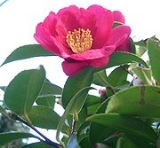
Camellia sasanqua
Encyclopedia
The Christmas Camellia (Camellia sasanqua) (or Yuletide) is a species of Camellia
native to the evergreen coastal forests of southern Japan
in Shikoku
, Kyūshū
and many other minor islands as far south as Okinawa. It is usually found growing up to an altitude of 900 metres.
It is an evergreen
shrub
growing to 5 m tall. The leaves
are broad elliptic, 3–7 cm long and 1.2–3 cm broad, with a finely serrated margin. The flower
s are 5–7 cm diameter, with 5-8 white to dark pink petals.
period, cultivars of Camellia sasanqua began appearing; the first record of the cultivars of this plant was made by Ihei Ito (1695–1733). In Japan, it is not considered to be a true Camellia as the Japanese call it Sazanka (サザンカ, 山茶花) .
Camellia sasanqua was not known in western societies until 1869 when Dutch traders imported some specimens into Europe
. It is now also introduced to Australia
and the United States
.
It has a long history of cultivation in Japan for practical rather than decorative reasons. The leaves are used to make tea while the seeds or nuts are used to make tea seed oil, which is used for lighting, lubrication, cooking and cosmetic purposes. Tea oil has a higher calorific content than any other edible oil available naturally in Japan.
It is known well by appearing in the lyrics of nursery rhyme called "Takibi".
Camellia
Camellia, the camellias, is a genus of flowering plants in the family Theaceae. They are found in eastern and southern Asia, from the Himalaya east to Korea and Indonesia. There are 100–250 described species, with some controversy over the exact number...
native to the evergreen coastal forests of southern Japan
Japan
Japan is an island nation in East Asia. Located in the Pacific Ocean, it lies to the east of the Sea of Japan, China, North Korea, South Korea and Russia, stretching from the Sea of Okhotsk in the north to the East China Sea and Taiwan in the south...
in Shikoku
Shikoku
is the smallest and least populous of the four main islands of Japan, located south of Honshū and east of the island of Kyūshū. Its ancient names include Iyo-no-futana-shima , Iyo-shima , and Futana-shima...
, Kyūshū
Kyushu
is the third largest island of Japan and most southwesterly of its four main islands. Its alternate ancient names include , , and . The historical regional name is referred to Kyushu and its surrounding islands....
and many other minor islands as far south as Okinawa. It is usually found growing up to an altitude of 900 metres.
It is an evergreen
Evergreen
In botany, an evergreen plant is a plant that has leaves in all seasons. This contrasts with deciduous plants, which completely lose their foliage during the winter or dry season.There are many different kinds of evergreen plants, both trees and shrubs...
shrub
Shrub
A shrub or bush is distinguished from a tree by its multiple stems and shorter height, usually under 5–6 m tall. A large number of plants may become either shrubs or trees, depending on the growing conditions they experience...
growing to 5 m tall. The leaves
Leaf
A leaf is an organ of a vascular plant, as defined in botanical terms, and in particular in plant morphology. Foliage is a mass noun that refers to leaves as a feature of plants....
are broad elliptic, 3–7 cm long and 1.2–3 cm broad, with a finely serrated margin. The flower
Flower
A flower, sometimes known as a bloom or blossom, is the reproductive structure found in flowering plants . The biological function of a flower is to effect reproduction, usually by providing a mechanism for the union of sperm with eggs...
s are 5–7 cm diameter, with 5-8 white to dark pink petals.
History and uses
At the beginning of the EdoEdo
, also romanized as Yedo or Yeddo, is the former name of the Japanese capital Tokyo, and was the seat of power for the Tokugawa shogunate which ruled Japan from 1603 to 1868...
period, cultivars of Camellia sasanqua began appearing; the first record of the cultivars of this plant was made by Ihei Ito (1695–1733). In Japan, it is not considered to be a true Camellia as the Japanese call it Sazanka (サザンカ, 山茶花) .
Camellia sasanqua was not known in western societies until 1869 when Dutch traders imported some specimens into Europe
Europe
Europe is, by convention, one of the world's seven continents. Comprising the westernmost peninsula of Eurasia, Europe is generally 'divided' from Asia to its east by the watershed divides of the Ural and Caucasus Mountains, the Ural River, the Caspian and Black Seas, and the waterways connecting...
. It is now also introduced to Australia
Australia
Australia , officially the Commonwealth of Australia, is a country in the Southern Hemisphere comprising the mainland of the Australian continent, the island of Tasmania, and numerous smaller islands in the Indian and Pacific Oceans. It is the world's sixth-largest country by total area...
and the United States
United States
The United States of America is a federal constitutional republic comprising fifty states and a federal district...
.
It has a long history of cultivation in Japan for practical rather than decorative reasons. The leaves are used to make tea while the seeds or nuts are used to make tea seed oil, which is used for lighting, lubrication, cooking and cosmetic purposes. Tea oil has a higher calorific content than any other edible oil available naturally in Japan.
It is known well by appearing in the lyrics of nursery rhyme called "Takibi".

